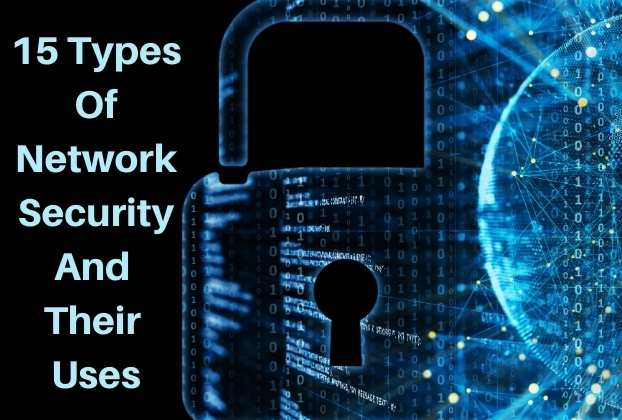15 Types Of Network Security And Their Uses
What is Network Security?
Network security is protecting a computer network from unauthorized access or attacks. It includes ensuring that data is not lost or corrupted. It also unauthorized users cannot access the network or its data. Network security is essential for businesses and individuals. It can help to protect sensitive information and prevent data breaches. Several measures can be taken to improve network security, for example, using firewalls, encrypting data, and implementing access control measures.
Why Is Network Security Important?
It's no obvious fact that the internet has turned into a part of our everyday lives. We use it for all that, from staying in contact with our loved ones to doing our work and shopping. But convenient as the internet is, it also comes with some risks. One of the most significant risks is the possibility of your computer or network being hacked.
That's why network security is so important. By taking measures to secure your network, you can help protect your computer and your data from being accessed by unauthorized people—one or two different ways of doing this include using firewalls and encrypting your data.
Network security is essential because it serves to keep your data safe. It's also important because it can help to prevent identity theft and other types of fraud. By taking steps to secure your network, you can help protect yourself and your family from becoming victims of these crimes.
What Are the Various Kinds of Network Security?
There are many types of network security, each with its advantages and disadvantages. The different types of network security include:
- Network Access Control
- Antivirus and Anti-malware Software
- Network Security Policies
- Application Security
- Email Security
- Firewalls
- Data Loss Prevention
- Antivirus Software
- Mobile Security
- Wireless Security
- Intrusion Prevention System (IPS)
- Network Segmentation
- Security Information and Event Management (SIEM)
- Web Security
- Virtual Private Network (VPN)
Network Access Control
Network Access Control (NAC) is a security measure that can be used to protect a network from unauthorized access. NAC can control what devices are allowed to connect to the network and what types of traffic are allowed to pass through the web. NAC can enforce security policies and prevent malicious or unauthorized devices from gaining access to the network.
Antivirus and Anti-malware Software
Antivirus and anti-malware software are computer programs that save your computer from viruses and other malware. These programs scan your computer for potential threats. It then works by isolating or removing the hazards. To be effective, antivirus and anti-malware software must be kept up-to-date with the latest threat definitions. It is essential to ensure that your software is set to update itself automatically.
Network Security Policies
A network security policy is a record that frames the security measures that an organization should install to protect its computer network. The policy should specify the types of devices and software. That allowed us to connect to the network and the procedures that should be followed to ensure the network's security.
Application Security
Application security identifies, prevents, and mitigates security risks in software applications. It is a broad area that covers everything from secure coding practices to secure communication and authentication. Application security is important because applications often target an attack. It can also contain sensitive data that needs to be protected. There are many ways to secure an application; the best approach depends on the specific application and its risks.
Email Security
Email security is a process or set of methods to protect email messages from unauthorized access. Email security usually involves encryption to protect the letter's contents from being read by anyone other than the intended recipient. Additionally, email security may include the use of authentication to verify the identity of a message sender. It can also ensure that the message has not been tampered with.
Firewalls
A firewall is a system that provides a barrier between a trusted internal network and untrusted external networks, such as the Internet. Firewalls can be hardware devices, software programs, or a combination. Hardware firewalls are usually installed as a single appliance. In contrast, software firewalls can be installed on individual computers or a network server.
Data Loss Prevention
Data loss prevention (DLP) is a term used to describe the measures taken to prevent the loss of sensitive or confidential data. This can include efforts to prevent data from being accidentally or deliberately deleted. It also acts to prevent data from being accessed or stolen.
Antivirus Software
Antivirus software is a type of program that is designed to protect your computer from malware. Malware is a sort of programming that can cause harm to your computer, and it can come in many structures—for example, infections, spyware, and adware. Antivirus software works by filtering your PC for malware and then removing it. It can likewise assist with malware from being installed in the first place. Antivirus software is an essential part of keeping your computer safe.
Mobile Security
Mobile security protects portable devices such as smartphones, tablets, and laptops from theft, loss, and malicious software. Thieves often target mobile devices because they are small, easy to carry, and usually contain personal and corporate data. Malicious software, for example, infections, Trojans, and worms, can infect mobile devices and lead to data loss or theft. They can also be utilized to get sufficiently close to corporate organizations.
Wireless Security
Wireless security prevents unapproved access or harm to PCs or data using wireless networks. The most common attacks are denial of service (DoS) attacks, man-in-the-middle attacks, and session hijacking.
- DoS attacks occur when attackers flood the target system with requests and prevent legitimate users from accessing it.
- Man-in-the-middle attacks happen when an attacker intercepts communication between two parties and impersonates each party as the other.
- Meeting commandeering occurs when an attacker dominates an active session between two parties and eavesdrops on communications.
Intrusion Prevention System (IPS)
An intrusion prevention system is a network security device. It monitors network traffic and looks for suspicious activity. which may show an attack. If the IPS detects a suspicious packet, it can take action to block the package or alert the administrator. Intrusion prevention systems are essential. Because they can stop attacks before they happen, rather than detect the incident.
Network Segmentation
Network segmentation divides a computer network into smaller subnetworks. Each consists of a group of connected devices that can communicate with one another. The segmentation method allows administrators to control and manage the network by isolating specific devices or groups of devices from the rest of the network. This isolation can help prevent problems from spreading throughout the web. It also makes identifying and troubleshooting issues more accessible.
Security Information and Event Management (SIEM)
Security Information and Event Management (SIEM) is a security discipline that combines security information management (SIM) and security event management (SEM). SIEM provides a holistic view of security events in an organization's environment.
Web Security
Web security is the process of protecting websites and web applications from security threats. It includes preventing attacks such as SQL injection, cross-site scripting (XSS), and malware injection. Web security also protects user data such as passwords, credit card details, and personal information.
Virtual Private Network (VPN)
A virtual private network, or VPN, is a private network to provide remote access to users. Also, it uses public infrastructure. A VPN permits users to securely access a private network, such as a corporate network, from a shared location, such as their home or office. A VPN can also securely connect two or more private networks. Such as two corporate networks, one corporate network, and one private home network.
Conclusion
As we have seen, network security is a complex and ever-evolving field. There is a wide range of sorts of assaults that can be launched against a network, and new threats are constantly emerging. A network must be continuously monitored and updated to defend against the latest threats and appropriately protected.
Despite the challenges, network security is essential to the safe operation of any computer network. By understanding the threats and taking steps to protect against them, organizations can help keep their networks secure and ensure that their data remains confidential.
Know About: 10 Most Common Types of Network Protocols and Their Uses






